The Fallen Arch
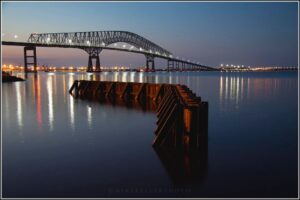
Once a symbol of strength, a towering span, The Key Bridge stood tall, connecting land to land.
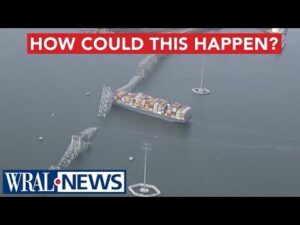
But now, its steel arches lie shattered and not to be mended, A tragic reminder of the nation untended.
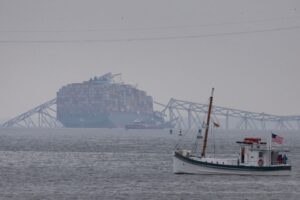
This bridge, a metaphor for our nation’s soul, Has crumbled, leaving us to bear the toll.
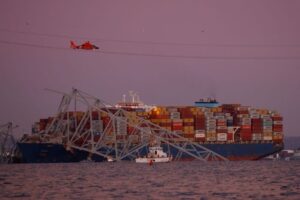
The foundations that once held us firm and true Have given way, leaving us adrift, unsure what to do.
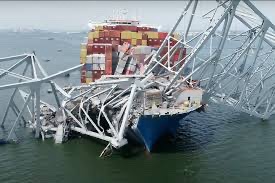
The roar of the river, once a steady beat, Now echoes the cries of those we can no longer meet.
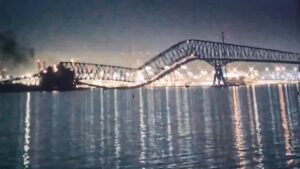
The lives lost, the dreams shattered, the future unclear – A somber reflection of the challenges we now fear.
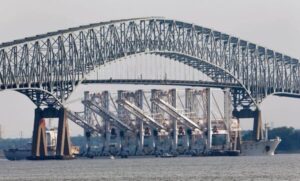
Yet, in the midst of this darkness, a glimmer of hope remains, For from the ashes, a new bridge must be raised.
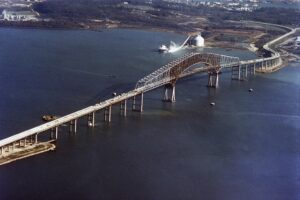
One that stands taller, stronger, and more resilient than before, Connecting us once more, as it had done in days of yore.
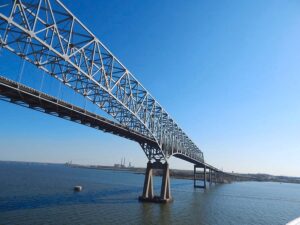
Let this be a call to action, a rallying cry, To rebuild, to restore, to never let our spirit die. For the Key Bridge, like our nation, must rise again, A symbol of unity, of strength, and of the bonds that sustain.
The Story of the Francis Scott Key Bridge
The Francis Scott Key Bridge, named after the author of the national anthem “The Star-Spangled Banner,” was an iconic landmark and vital transportation link in Baltimore, Maryland. Its history is deeply intertwined with the city’s cultural identity and the nation’s history.
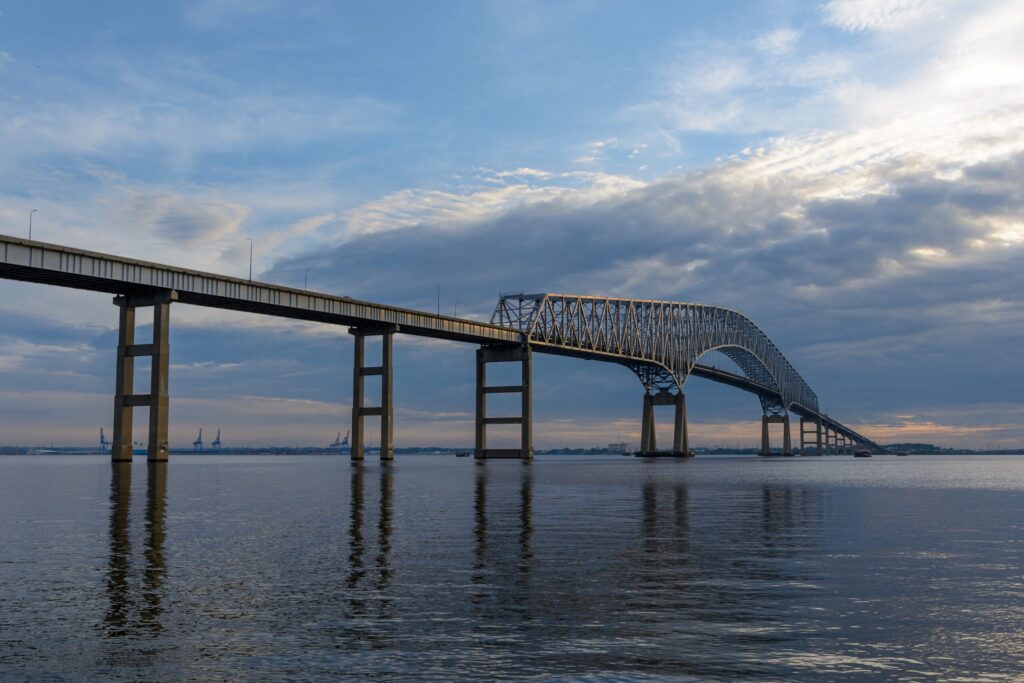
Origins and Construction
The bridge’s story began in the early 1960s, when the Baltimore Harbor Tunnel (Interstate 895) had reached its traffic capacity, leading to heavy congestion and delays during rush hours. Plans were made for a second tunnel, but construction bids came in higher than expected, prompting a shift to building a bridge instead3. Construction on the 1.6-mile bridge started in 1972 and was completed in 1977, with the bridge officially opening on March 23, 197712. The four-lane span was designed as an outer crossing of the Baltimore Harbor, providing an alternative to the tunnel and the ability to handle vehicles carrying hazardous materials3.
The Key Bridge was a steel arch continuous through truss bridge that spanned the lower Patapsco River and the outer Baltimore Harbor. It carried four lanes of Interstate 695 (I-695) and connected the southern neighborhood of Baltimore, Hawkins Point, with Dundalk in Maryland. The bridge’s total length was 8,636 feet (2,632.3 m; 1.6 mi), with the longest span measuring 1,200 feet (366 m). The bridge had a clearance below of 185 feet (56 m), allowing for the passage of large ships3.
Historical Significance
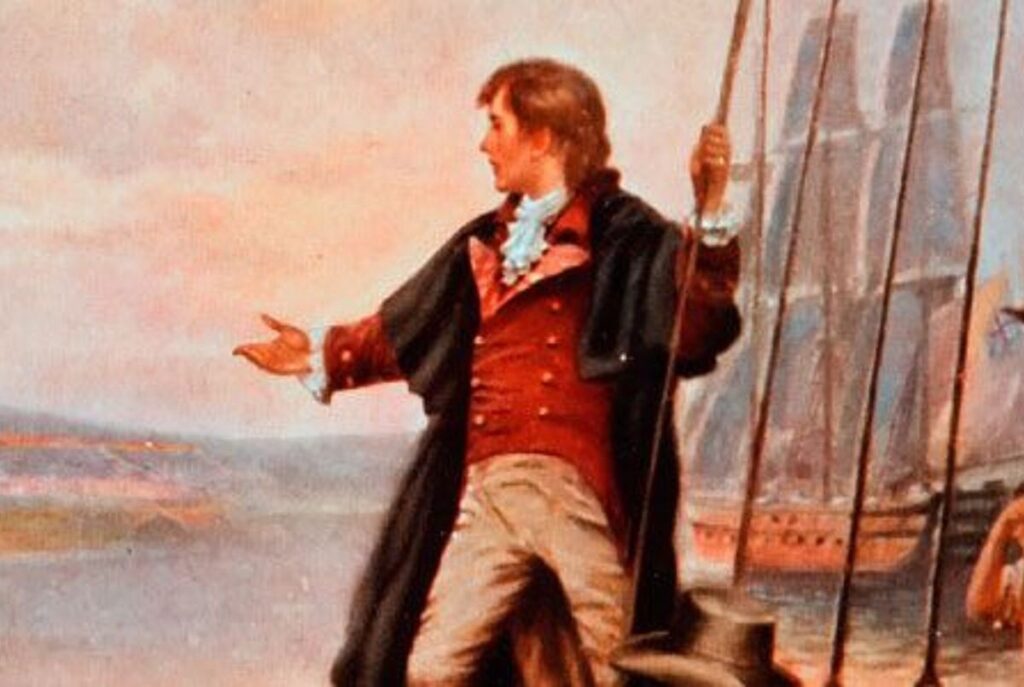
The bridge was built mere yards from the site where Francis Scott Key witnessed the British bombardment of Fort McHenry in 1814, an event that inspired him to write the poem that became the national anthem4. This connection to a pivotal moment in American history made the bridge a symbol of Baltimore’s resilience and the nation’s enduring spirit.
The bridge itself was constructed much later, with its construction beginning in 1972. It was designed by the J. E. Greiner Company and built by Beasley Construction Company, with materials fabricated by the Pittsburgh-Des Moines Steel Co. The bridge was officially opened to traffic on March 23, 1977, and was one of the longest continuous truss bridges in the United States at the time235.
Impact on Baltimore
The Key Bridge quickly became a vital part of Baltimore’s infrastructure, carrying about 30,000 commuters and 11.3 million vehicles per year34. It was a landmark in the city’s skyline and an “artery for commerce,” connecting Dundalk to Baltimore and the world2.
Collapse and Aftermath
On March 26, 2024, the bridge tragically collapsed after being struck by the container ship MV Dali, which had lost power and collided with one of the bridge’s piers12.
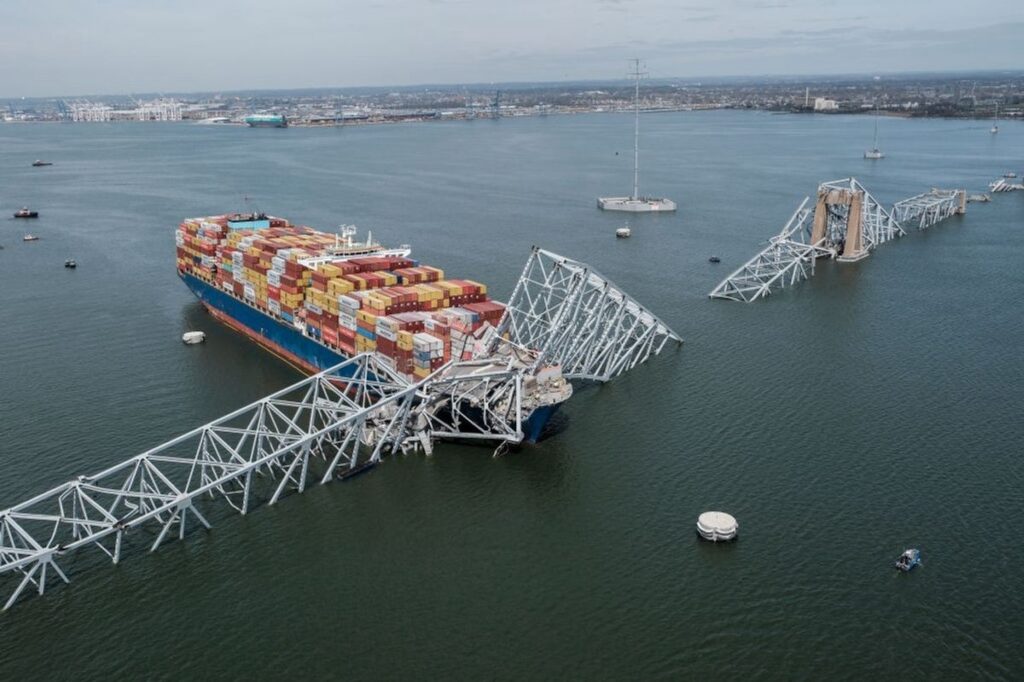
The main spans and part of the northeastern approach of the Key Bridge collapsed after the Singapore-registered container ship MV Dali struck one of its piers at 01:27 EDT (05:27 UTC) on March 26, 2024. The incident was declared a “mass casualty incident,” with sonar exploration detecting several vehicles underwater. Two people were rescued from the river, while six workers were presumed dead34.
The Dali is a Singapore-registered container ship that has a capacity of nearly 10,000 standard 20-foot shipping containers. At the time of the incident, it was carrying around 4,700 containers of various cargo, including:
- Automobiles – The Port of Baltimore is a major hub for handling automobiles, and the bridge collapse is expected to disrupt the supply chains and distribution of vehicles.
- Other commodities – The port also handles significant amounts of other cargo such as coal, coffee, sugar, and other general goods.
- Containers – The Dali had a capacity of nearly 10,000 standard 20-foot shipping containers and was carrying around 4,700 containers at the time of the incident2.
The specific details of the exact cargo breakdown on the Dali are not provided in the search results. However, the information indicates that the ship was transporting a diverse mix of containerized and bulk cargo that is typical for a large container vessel calling at the Port of Baltimore.
The MV Dali is a Singapore-registered container ship owned by Grace Ocean Private Ltd. and managed by the Singapore-based Synergy Marine Group. The vessel, which had a crew of 22 Indian nationals, including two pilots, was chartered by shipping giant Maersk and was on its way out of the Port of Baltimore when it lost power and collided with the Key Bridge3.
Maersk is a Danish company with its headquarters in Copenhagen3. It was founded on April 16, 1904, by the captain Peter Mærsk-Møller and his son Arnold Peter Møller3. The company has grown significantly over the years, with its current president being Nils Smedegaard Andersen3. Maersk operates in many business sectors, with a focus on transport and energy3. It has agencies and branches in over 135 countries around the world, employing more than 120,000 workers3.

Maersk’s history includes the launch of liner service between the United States and Asia in 1928, the establishment of a new ship brokering operation, Maersk Company, in the United Kingdom in 1951, and the introduction of sea container shipping in 19562. The company also expanded into oil and gas exploration and production in 1962, and diversified into other areas such as transportation and support services for offshore operations2.
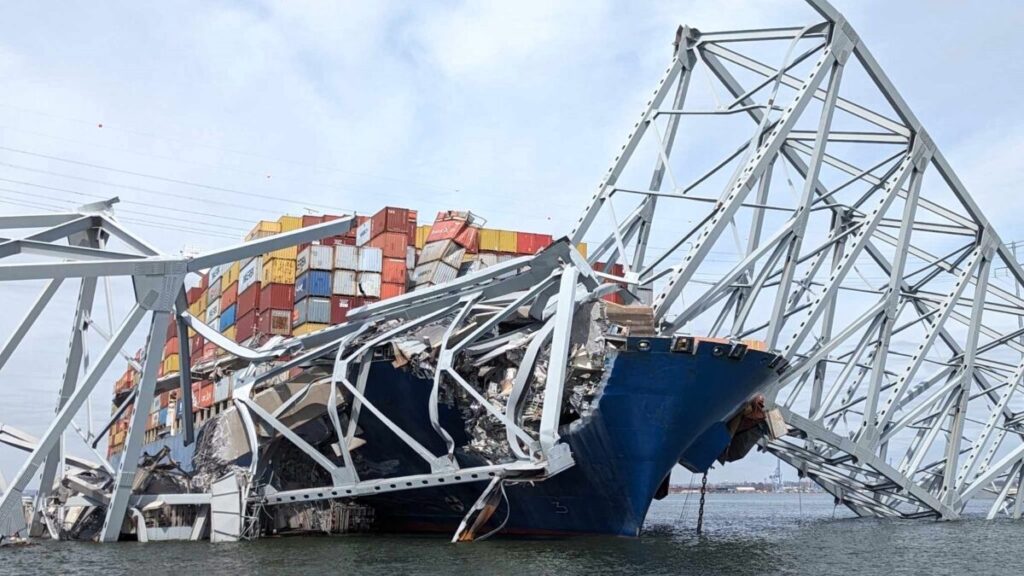
The incident began when the Dali’s lights went out at approximately 1:24 a.m. on March 26, 2024. The ship, which was about 984 feet long and had a capacity of nearly 10,000 TEUs (20-foot equivalent units), was effectively rudderless and at the mercy of the currents2. It is unclear whether an anchor was dropped or if the vessel was drifting when it hit the bridge.
Tugboats, such as the Eric McAllister and Bridget McAllister, were available in the area but were not called upon to assist the Dali.
Many have asked why tugs weren’t used. This is an important point and points to broader questions that will be asked of Baltimore port control about their overall safety management system, something that is every bit as relevant to this accident as the ‘loss of control’ suffered on the ship. Dali was doing about eight knots at the time of the incident which is approaching the upper speed of most tugs, certainly the upper speed at which they can have any lateral effect on a ship of that size, so a tug forward ‘pushing off’ in the traditional sense would have struggled.
How to Understand the Baltimore Bridge Collapse
By Chas Danner, staff editor at Intelligencer
The Baltimore port does not require extended tugboat escorts into the channel tugboats are just one part of a complex safety matrix that also includes concrete fenders for bridges1.
The bridge rests on four supports, two of which sit each side of the navigable waterway. It is these two piers that are critical to protect against ship impacts. And indeed, there were two layers of protection: a so-called “dolphin” structure made from concrete, and a fender. The dolphins are in the water about 100 metres upstream and downstream of the piers. They are intended to be sacrificed in the event of a wayward ship, absorbing its energy and being deformed in the process but keeping the ship from hitting the bridge itself.
The fender is the last layer of protection. It is a structure made of timber and reinforced concrete placed around the main piers. Again, it is intended to absorb the energy of any impact. Fenders are not intended to absorb impacts from very large vessels. And so when the MV Dali, weighing more than 100,000 tonnes, made it past the protective dolphins, it was simply far too massive for the fender to withstand.
How to Understand the Baltimore Bridge Collapse
By Chas Danner, staff editor at Intelligencer
It is also unclear whether helm control was lost before the collision. Responsibility for repairing the Key Bridge lies with the state of Maryland, as the bridge is operated by the Maryland Port Administration1.
The collapse was a devastating blow to Baltimore, with Maryland Governor Wes Moore describing it as “heartbreaking” and a loss of a piece of the city’s cultural identity2. The collapse has had significant economic impacts, effectively closing the Port of Baltimore, a major economic engine for the region. Efforts are underway to mitigate the disruptions and rebuild the iconic bridge, with the federal government pledging support for the reconstruction3.
several measures are being taken to mitigate the economic impact of the Key Bridge collapse in Baltimore:
- State Assistance:
- The Maryland state government has introduced the “Maryland Protecting Opportunity and Regional Trade Act” to authorize the governor to use a portion of the state’s $2 billion rainy-day fund to help offset the immediate economic impacts of the bridge closure.
- The goal is to protect the economic engine of the Port of Baltimore and ensure that businesses and industries that rely on the port do not permanently relocate elsewhere.
- Federal Involvement:
- The Biden-Harris Administration’s Supply Chain Disruptions Task Force has convened to assess the potential impacts on regional and national supply chains due to the bridge collapse and port closure.
- The task force is engaging with industry, ocean carriers, ports, and labor unions to minimize disruptions as shipments are rerouted to alternative ports.
- Federal agencies, including the Department of Transportation, Department of Commerce, and Department of Agriculture, are participating in the task force to coordinate response and mitigation efforts.
- Rerouting and Diversification:
- Efforts are underway to reroute cargo and shipments to other ports, such as those in Wilmington, Delaware, and Philadelphia, to maintain the flow of commerce.
- There is a recognition of the need for a port strategy that relies on multiple ports, not just a few large ones, to prevent the closure of a major US port from having such a significant economic impact.
- Worker and Community Support:
- The task force is monitoring the impact of the closure on workers directly associated with activities at the Port of Baltimore and will work with the Department of Labor, the state of Maryland, and impacted employers and unions to minimize impacts on these workers and the surrounding community.
The overall goal is to protect the economic engine of the Port of Baltimore, maintain the flow of commerce, and support the workers and communities affected by the bridge collapse and port closure. The state and federal governments are taking proactive measures to mitigate the short-term and long-term economic impacts of this significant infrastructure failure.
Short-Term Impacts
- The collapse has effectively closed the Port of Baltimore, which is a major economic engine for the region. The port handles about 50 million tons of goods valued at $80 billion annually, ranking it among the top 20 ports nationally by tonnage and top 10 by value.
- The port closure will disrupt the supply chains and distribution of a wide range of goods that pass through the port, including automobiles, coal, coffee, sugar, and other commodities.
- The bridge closure will also impact nearby distribution facilities for companies like Amazon, FedEx, Under Armour, Volkswagen, and BMW, as they rely on the bridge for transportation.
- The loss of the bridge, which carried about 15% of the region’s bridge traffic, will cause significant diversions and delays for passenger and commercial vehicles, adding miles and costs to their trips.
Medium to Long-Term Impacts
- Rebuilding the Key Bridge is expected to take years and cost hundreds of millions of dollars, further straining the regional economy.
- The prolonged closure of the port and disruption to transportation networks could have ripple effects throughout the broader state and national economies, impacting industries and consumers that rely on goods flowing through Baltimore.
- Following the collapse, there is a discussion about the introduction of redundant support structures in bridge design, which are widely used in modern bridges and could prevent such collapses. The National Transportation Safety Board (NTSB) indicated that the Key Bridge was constructed prior to the adoption of these redundant support structures. The incident has highlighted the need for updated safety measures and engineering practices to prevent similar accidents in the future3.
- There are concerns about the economic impacts on particular products that heavily rely on the Port of Baltimore, such as automobiles, coal exports, and other key commodities.
Overall, the collapse of the Key Bridge represents a major economic disruption for Baltimore, Maryland, and potentially the broader national economy, given the port’s importance as a transportation and trade hub. Restoring the bridge and port operations will be a complex and costly endeavor.
The Francis Scott Key Bridge was more than just an engineering feat – it was a symbol of Baltimore’s history, resilience, and connection to the nation. Its collapse has left a profound impact on the city and the region, but the determination to rebuild and restore this vital link remains strong.


